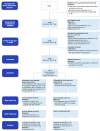The Feasibility and User-Experience of a Digital Health Intervention Designed to Prevent Weight Gain in New Kidney Transplant Recipients-The ExeRTiOn2 Trial
- PMID: 35677553
- PMCID: PMC9168981
- DOI: 10.3389/fnut.2022.887580
The Feasibility and User-Experience of a Digital Health Intervention Designed to Prevent Weight Gain in New Kidney Transplant Recipients-The ExeRTiOn2 Trial
Abstract
Half of kidney transplant recipients (KTRs) gain more than 5% of their body weight in the first year following transplantation. KTRs have requested support with physical activity (PA) and weight gain prevention, but there is no routine care offered. There are few high-quality studies investigating the clinical value of diet, PA or combined interventions to prevent weight gain. The development and evaluation of theoretically informed complex-interventions to mitigate weight gain are warranted. The aims of this mixed-methods randomized controlled trial (RCT) were to explore the feasibility, acceptability and user-experience of a digital healthcare intervention (DHI) designed to prevent post-transplant weight gain, in preparation for a large multi-center trial. New KTRs (<3 months) with access to an internet compatible device were recruited from a London transplant center. The usual care (UC) group received standard dietary and PA advice. The intervention group (IG) received access to a 12-week DHI designed to prevent post-transplant weight gain. Primary feasibility outcomes included screening, recruitment, retention, adherence, safety and hospitalizations and engagement and experience with the DHI. Secondary outcomes (anthropometrics, bioimpedance, arterial stiffness, 6-minute walk distance and questionnaires) were measured at baseline, 3- and 12-months. 38 KTRs were screened, of which 32 (84.2%) were eligible, and of those 20 (62.5%) consented, with 17 participants (85%) completing baseline assessment (Median 49 years, 58.8% male, Median 62 days post-transplant). Participants were randomized using a computer-generated list (n = 9 IG, n = 8 UC). Retention at 12-months was 13 (76.4%) (n = 6 IG, n = 7 UC). All a priori progression criteria were achieved. There were no associated adverse events. Reflexive thematic analysis revealed four themes regarding trial participation and experience whilst using the DHI. Halting recruitment due to COVID-19 resulted in the recruitment of 40% of the target sample size. Mixed-methods data provided important insights for future trial design. A definitive RCT is warranted and welcomed by KTRs.
Clinical trial registration: www.clinicalTrials.gov, identifier: NCT03996551.
Keywords: behavior change; kidney transplantation; physical activity; web-based intervention; weight gain prevention.
Copyright © 2022 Castle, Dijk, Asgari, Shah, Phillips, Greenwood, Bramham, Chilcot and Greenwood.
Conflict of interest statement
The authors declare that the research was conducted in the absence of any commercial or financial relationships that could be construed as a potential conflict of interest.
Figures




Similar articles
-
Feasibility and acceptability of a televideo physical activity and nutrition program for recent kidney transplant recipients.Pilot Feasibility Stud. 2020 Sep 10;6:126. doi: 10.1186/s40814-020-00672-4. eCollection 2020. Pilot Feasibility Stud. 2020. PMID: 32944274 Free PMC article.
-
Usability and experience testing to refine an online intervention to prevent weight gain in new kidney transplant recipients.Br J Health Psychol. 2021 Feb;26(1):232-255. doi: 10.1111/bjhp.12471. Epub 2020 Sep 15. Br J Health Psychol. 2021. PMID: 32931645
-
Safety and Efficacy of Imatinib for Hospitalized Adults with COVID-19: A structured summary of a study protocol for a randomised controlled trial.Trials. 2020 Oct 28;21(1):897. doi: 10.1186/s13063-020-04819-9. Trials. 2020. PMID: 33115543 Free PMC article.
-
A Randomized Controlled Trial of an Intensive Nutrition Intervention Versus Standard Nutrition Care to Avoid Excess Weight Gain After Kidney Transplantation: The INTENT Trial.J Ren Nutr. 2018 Sep;28(5):340-351. doi: 10.1053/j.jrn.2018.03.001. Epub 2018 May 2. J Ren Nutr. 2018. PMID: 29729825 Clinical Trial.
-
The effect of intensive nutrition interventions on weight gain after kidney transplantation: protocol of a randomised controlled trial.BMC Nephrol. 2014 Sep 9;15:148. doi: 10.1186/1471-2369-15-148. BMC Nephrol. 2014. PMID: 25204676 Free PMC article. Clinical Trial.
Cited by
-
Piloting an online telecoaching community-based exercise intervention with adults living with HIV: protocol for a mixed-methods implementation science study.BMJ Open. 2023 Mar 30;13(3):e067703. doi: 10.1136/bmjopen-2022-067703. BMJ Open. 2023. PMID: 36997255 Free PMC article.
-
Preferences of people with chronic kidney disease regarding digital health interventions that promote healthy lifestyle: qualitative systematic review with meta-ethnography.BMJ Open. 2024 May 27;14(5):e082345. doi: 10.1136/bmjopen-2023-082345. BMJ Open. 2024. PMID: 38802278 Free PMC article.
-
"Own doctor" presence in a web-based lifestyle intervention for adults with obesity and hypertension: A randomized controlled trial.Front Public Health. 2023 Mar 14;11:1115711. doi: 10.3389/fpubh.2023.1115711. eCollection 2023. Front Public Health. 2023. PMID: 36998287 Free PMC article. Clinical Trial.
-
Lifestyle interventions delivered by eHealth in chronic kidney disease: A scoping review.PLoS One. 2024 Jan 24;19(1):e0297107. doi: 10.1371/journal.pone.0297107. eCollection 2024. PLoS One. 2024. PMID: 38266006 Free PMC article.
-
Patients' acceptability of self-selected digital health services to support diet and exercise among people with complex chronic conditions: Mixed methods study.Digit Health. 2024 Jun 7;10:20552076241245278. doi: 10.1177/20552076241245278. eCollection 2024 Jan-Dec. Digit Health. 2024. PMID: 38854917 Free PMC article.
References
Publication types
Associated data
LinkOut - more resources
Full Text Sources
Medical

